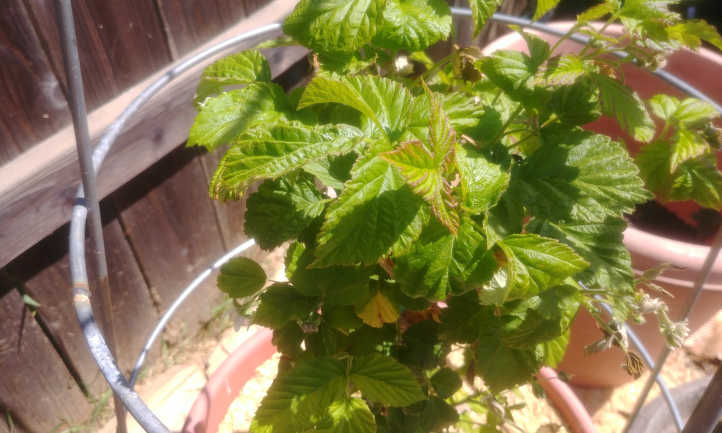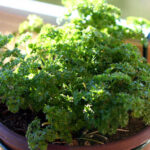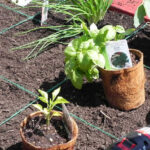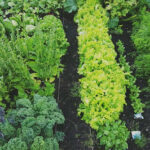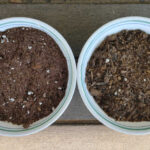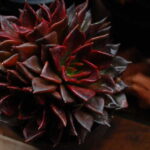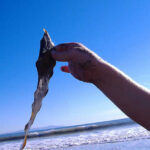Have you always wanted to grow raspberries but don’t have a permanent space? Or maybe your planting area doesn’t get much sun? Perhaps your apartment didn’t come with a yard or garden, but does have a sunny balcony or deck?
Growing raspberry plants in containers is easy and if you choose the right varieties, you could even harvest fresh raspberries several times during the season!
There are also practical reasons for growing raspberries in containers:
- Raspberries in pots can be moved – to a sunny spot or a new abode
- The nutrient content and health of the soil can be controlled
- Invasive spreading is contained
Now’s the perfect time for growing raspberries in containers! We’ll share the right techniques to get you started. But let’s start with a few great suggestions for the perfect container raspberries to grow!
Get a Raspberry Shortcake Plant
Get a Heritage Everbearing Plant
Get a Golden Anne Raspberry Plant
Quick Care Guide

| Common Name(s) | Red raspberry, European raspberry |
| Scientific Name | Rubus idaeus |
| Months of Harvest | Summer bearing June/July; Everbearing varieties, June and September |
| Light | Full sun |
| Water: | Consistent moisture |
| Soil | Slightly acidic (pH 6.0-6.2), rich, well-draining |
| Fertilizer | Compost and balanced organic NPK fertilizer |
| Pests | Aphids, cane borers, raspberry beetles/ fruitworm, birds |
| Diseases | Anthracnose, spur blight, cane blight, Botrytis fruit rot (gray mold), raspberry leaf curl virus |
Best Raspberries For Containers
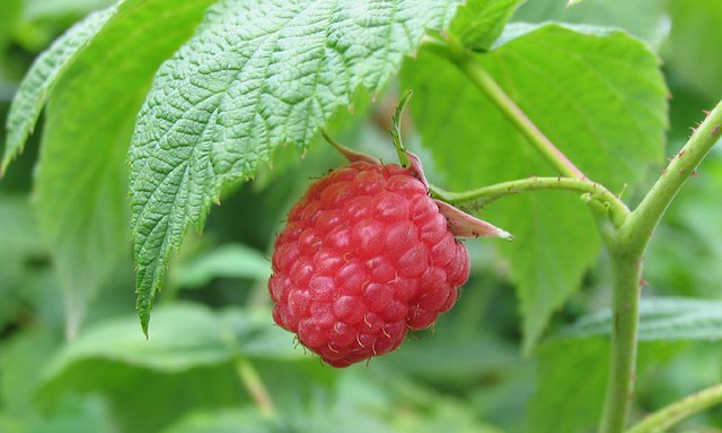
There are some newer bush raspberry varieties completely intended for containers but traditional summer fruiting and everbearing varieties can also do well in pots. When choosing your variety, decide when you would like to harvest your berries. Summer fruiting varieties ripen throughout one month around late June and everbearing types kick out ripe berries both in mid-summer and early fall.
When we think of raspberries we usually imagine the red, bite-sized fruits (Rubus idaeus), but keep in mind that there are other varieties that produce delicious yellow or gold, purple, and black berries. I’m often surprised at the sweet, typical raspberry taste of yellow/gold varieties because they look like they should taste like something else!
There are many raspberry plant varieties that will do well in a container garden. Planting certified disease-free plants from nurseries is recommended. Keep reading for some ideas.
Raspberry Shortcake: These bush raspberries were developed to grow in containers. The plants are compact and thornless with a round, bush shape that is stunning for landscaping. Its easy-to-harvest red berries ripen midsummer. Raspberry Shortcake is self-pollinating and doesn’t require staking, as its canes are close together and only reach about 2-3 feet in height.
Heritage Raspberry Bush: Heritage is an everbearing bush variety that will also grow well in containers without support. Heritage is the most common red variety and grows prolifically in most climates and up to 5-6 feet in height. Berries are large and freeze well.
Red Latham: Red Latham is a self-pollinating summer bearing variety that fruits in late June to mid-July. Canes grow to 4-6 feet high and produce glowing red-colored berries. With less foliage than other varieties, it’s convenient to grow in containers and will require staking.
Anne: Anne is a self-pollinating everbearing variety that produces sweet, pale yellow berries. New canes will fruit in the fall of their first year and the early summer of their second year. Growers rave about their sweet taste and cold-hardiness.
Glencoe Purple Thornless Floricane Raspberry: Glencoe Purple is a cross between black and red raspberry plants, resulting in its lovely purple color and excellent flavor. It’s a non-spreading, bushy variety that reaches less than three feet tall, making it great for a container garden. Tolerates heat better than some varieties.
Growing Raspberries In Containers
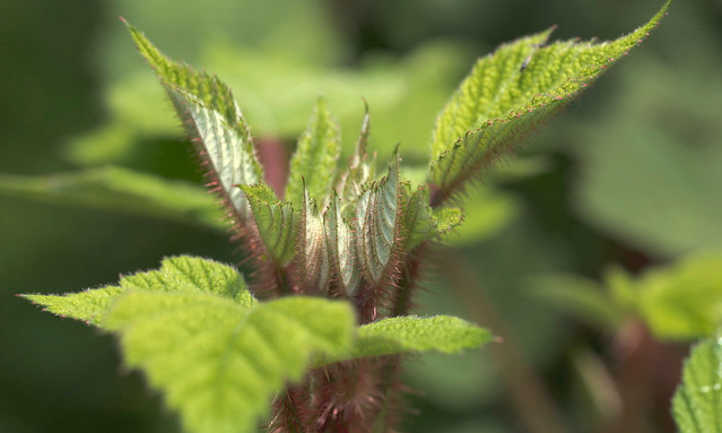
Now that you have some ideas for which varieties to grow, here are some tips for how to grow raspberries in a container.
Container Preparation
Growing raspberries in pots that are wide and deep will guarantee that your plants have enough space for new growth and any stakes or trellises if support is needed. One cane would do well in a sixteen-inch pot and if you are planting several canes, try half-barrels or five-gallon buckets. Grow bags (we prefer Root Pouch) are also an option but may be less stable than a plastic or wooden planter. Remember that containers need drainage holes or be of nonwoven material to allow excess water to drain. Raspberries hate having “wet legs.”
Summer-bearing varieties need support because their canes tend to be taller and will bend with summer fruit. There are many options for supporting your canes. Depending on the shape of your container, tomato cages work well. A simpler, budget-friendly option is to press tall garden stakes into the perimeter of each container and tie twine around them at several heights for support.
Soil Requirements
A main benefit of container gardening is the ability to control soil type and nutrients. Raspberries in pots require slightly acidic (pH 6.0-6.2), nutrient-retaining, well-draining soil. For comparison, blueberries require quite acidic soil around pH 4.5-5.5.
Any good, bagged potting soil will work well for these containers, although it’s important to amend the potting soil with acidifying elements like compost, aged manure, or peat moss. Compost and manure also provide essential nutrition and peat moss helps retain moisture. A balanced NPK rounds out nutritional needs and there are more details in the fertilizing section below.
Planting Raspberries
Raspberries are sold either as dormant bare-root or live potted plants. Bare-root canes look rather scraggly and unimpressive and you may feel the urge to pack more than one cane into a small container. For plant health and dynamite berry production, stick to one cane per sixteen inch container, and several canes per 5-gallon container or larger.
Once you’ve put together the amended potting soil mixture in your container, make a hole large enough for your bare-root plant to sit comfortably without crowding its roots. The soil should cover the plant about 1 to 3 inches above the roots. Gently press the soil around the roots and water well. Make sure to add more soil if you notice that the soil settles low after watering.
The method for transplanting a live potted plant is nearly identical, except that it should be set at the same depth as it was growing in the pot.
After transplanting bare-root or live potted plants, add your stakes or trellises so you don’t damage roots by adding them later. Mulch the soil surface with straw, wood chips, or similar organic material. Mulching helps control weeds and, more importantly for raspberries, preserves moisture.
Caring For Your Raspberry Planter

Now that your plants are established in their roomy pots, a few conditions need to be met in order guarantee a great harvest.
Sunlight & Temperature
Raspberries can tolerate partial shade, but your berry harvest will be much better if you can find full sun. That said, raspberries are sensitive to high temperatures and do best in growing zones 4-8. Specific varieties have been developed that thrive in zones 9 and above, so make sure when purchasing your plants they are a good match for your zone.
Watering
Generally, a container garden requires more water than plants grown in the ground because of exposure to and less protection from the elements. Avoid planting in unglazed terra cotta pots, as they wick moisture away from the soil especially fast.
The key is to keep the soil consistently moist but not wet. Watering 2-3 times a week is usually sufficient. In windy areas, hot, dry climates or during heat waves, you may need to water your potted raspberries a couple times a day. A soaker hose can provide slow, deep watering.
Once your plants have stopped producing berries, it is no longer necessary to water regularly.
If you live in an area with harsh winters, consider overwintering your pots in an unheated garage. Water the plants only enough to keep them alive during the winter months and then move them back to a sunny area after your area’s frost free date.
Fertilizing
Adding a balanced fertilizer when preparing your soil for planting will provide a nutritional boost for your plants. When combined with compost at planting time, a powdered organic 10-10-10 fertilizer will help sustain your plants for 3-4 months. While the plants are growing you can also supplement once or twice a month with a liquid kelp fertilizer foliar spray for ongoing support.
The spring after your first growing season, fertilize your container raspberries again with the 10-10-10 fertilizer, once in March and again in May. Add compost to the container throughout the season and mulch the soil surface for weed and moisture control.
Pruning
Red and yellow varieties produce new, green canes called Primocanes every year. Primocanes don’t produce fruit the first year. They brown and mature from season to season and are ready to produce fruit in the second year. This is important to know for pruning and maintenance of your plants.
Pruning is needed several times during the season:
- In spring to clean up any damaged or ill canes
- Mid-season for size and height control
- Fall clean-up after harvest to prepare the plants for winter
Fall clean-up is the most pruning-intensive time. Prune large green canes down to 4-5 feet and using good pruning shears cut the wimpy ones down to 1 inch. Cut brown canes that have finished fruiting down to the soil line. Prune during dry weather in order to prevent exposure to harmful fungal diseases.
For a jumpstart in spring, overwinter your potted raspberries in an unheated garage or shed. With infrequent watering they will become dormant. Moving your plants to a sunny, warm spot in spring and adding water will wake them up.
Troubleshooting
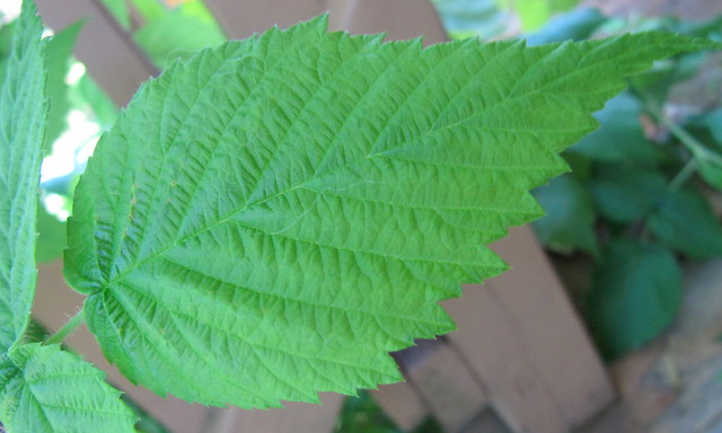
While there’s only a handful of issues to be aware of, they can become major problems. Read on to find out how best to prevent these problems before they start.
Pests
Aphids pierce individual plant cells and devour plant juices. If you see curly, yellow, or malformed leaves on your plants, you may have an aphid problem. Look for the tiny insects on the undersides of leaves and plant stems. A neem oil spray is effective for controlling these pests.
Cane borers are beetle pests that eat the tips of new plant canes. If you notice that your canes’ tips look wilted, take a closer look! The beetles are slender and ¼ inch long, with a copper-red neck. Their larvae is white and grub-like. To treat, prune the canes at least 6 inches below where the wilting starts, which should also remove any lurking larvae.
Raspberry beetle/fruitworm damage is easy to spot. Small, red-brown beetle adults skeletonize new leaves and canes. Fruitworms are their larvae that burrow into fruit caps and the worms are obvious. Hand-picking the tiny worms is possible, but a bacillus thurigiensis spray may be more effective. Bacillus thurigiensis is certified for use in organic gardens and does not harm bees and other beneficial insects.
Birds like to eat raspberries as much as you do! If your neighborhood birds take an interest in your ripe berries, cover the plants with protective netting.
Diseases
Fungal blights like anthracnose, spur blight, and cane blight cause spreading pits, spots, and wounds on the canes and, eventually, plant death. Fungi thrive in wet conditions and spread from plant to plant by splashing water. Fungi are difficult to treat and can stick around for 2 years or more. Infected canes should be pruned and destroyed (not composted). Disease prevention is your best course: prune only during dry weather, keep plants healthy by watering and fertilizing appropriately, and purchase resistant varieties.
Botrytis fruit rot (gray mold fungus) affects brambles and other berries during extended rainy, cloudy, warm weather. Blossoms and fruit become covered with fuzzy, gray powder and spreads to nearby fruits during picking. Botrytis fruit rot can be avoided. Your containers need good drainage, plenty of air flow between leaves and plants, and full sun. If you see gray mold on your berries, remove and dispose of them carefully.
Raspberry Leaf Curl Virus is an incurable disease caused by aphids. Signs of the disease include discolored, curled leaves, brittle canes, and crumbly fruits. Treatment for this disease is to remove the infected plants. When purchasing plants, make sure that they are certified virus-free. It is also important to clean your pruning shears and other garden tools to prevent spreading diseases to healthy plants.

